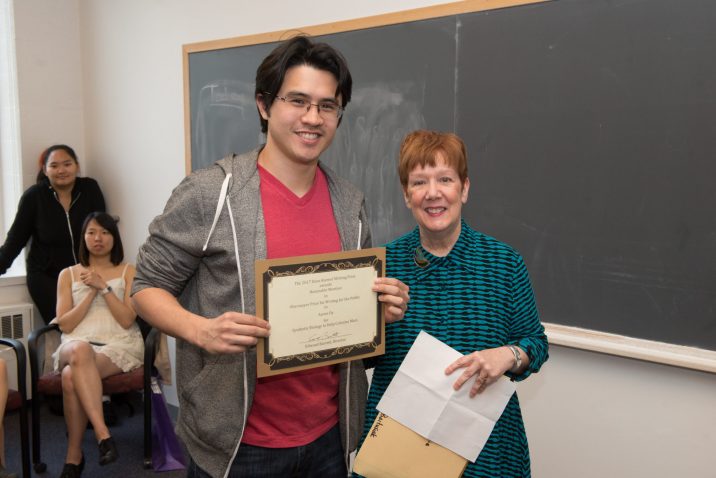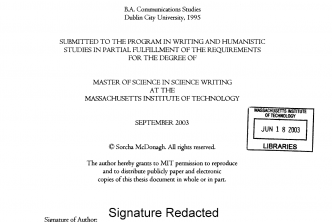“Synthetic Biology to Help Colonize Mars” won honorable mention for the 2017 Obermayer Prize for Writing for the Public.
Shannon Nangle finished her Ph.D. in 2015 ready to take on a new challenge and set her sights on research to help make Mars colonization possible. But she isn’t pursuing research on rocket fuels or space suits. She’s using synthetic biology to improve biomanufacturing of needed resources using simple inputs like sunlight, water, and CO2.
Synthetic biology as an emerging technology
Synthetic biologists try to engineer biology to achieve things that may not be possible with non-biological technologies. This attempt to use our knowledge of biology and its parts to create biological circuits will let us make use of the tasks that biology has evolved to do well. In the last few decades, technological advances in our ability read, write, and edit DNA have begun to make engineering biology possible, much like fundamental tools and understanding of electricity lead to the creation of electronic circuits.
In electrical engineering the diode, which acts like a one-way electrical valve that allows for things like AC to DC conversion and voltage regulation, was patented in 1904. By the 1950s, we had transistors that let electronics be reduced to a reasonable size without the need for huge vacuum tubes. In another 50 years, the personal computer had made its mark on society and become critical to almost all of our modern activity.
If we made a similar timeline for current synthetic biology it would probably be somewhere near the transistor period. Major DNA cloning techniques go back to the 1980s and the Human Genome Project went on throughout the 1990s. What came to be referred to as synthetic biology started around the year 2000 with bacteria engineered to have simple memory or oscillate like a biological clock. A whole field with its own conferences and academic journals has grown up since. Many researchers have joined the field to build up the types of functions that biological cells could be programmed to do and to work toward biological solutions to grand challenges.
Engineered bacteria to make bioplastics
In 2015, work between Pam Silver and Daniel Nocera’s labs showed that the bacterium Ralstonia eutropha (R. eutropha) could be used along with water splitting to create biomass and fusel alcohols. Then in 2016 they followed up with ‘bionic leaf 2.0’ that used a more biocompatible catalyst combined with an engineered R. eutropha to beat the efficiency of natural photosynthesis. Now, synthetic biology approaches are being used to expand and scale up this efficient solar to bioproduct innovation.
To find out about the latest work to help move the bionic leaf out of the lab and maybe one day to Mars, I met with postdoc Shannon Nangle and graduate student Marika Ziesack, both members of Pamela Silver’s lab, in their Harvard Medical School lab space. I saw the benchtop setup for testing R. eutropha with the biocompatible catalysts. A power source connects to the small electrodes that sit in the compartment with the bacteria. As the electricity is applied it splits water–which as H2O has two hydrogens and one oxygen atom– into hydrogen and oxygen. The bacterium, R. eutropha in this case, can then use that hydrogen along with carbon dioxide (CO2) to produce biomass like the bioplastic building block polyhydroxybutyrate (PHB) which can be used in 3D printing.
R. eutropha can also be engineered to overproduce certain fatty acids and enzymes that allow for more biopolymers than just PHB. That’s one of the improvements that Shannon and Marika are working on so that biopolymers with different structural properties can be produced and used as biodegradable materials here on earth or as renewable building blocks on Mars.
Other engineering improvements can be made so the bacteria can tolerate stresses like high salt concentrations that can improve conductivity of the solution. They even mentioned the possibility of a bacterium that can grow in a mixture that includes urine waste to allow more sustainable water recycling. Bacteria grown in a lab or production facility usually need a feedstock of biomass that can end up being the big cost in the bioplastic production. With sunlight, water, and air as inputs it’s possible to bypass the expensive feedstocks that would be normally be used to create these bioplastics.
Moving out of the lab (and maybe some day to Mars)
To truly tackle applications like space exploration, synthetic biology will need to prove itself in the field. Others have noted that synthetic biology can be crucial to a Mars mission but first it has to get off of a lab bench. That’s why the team at Harvard are working on more portable versions of the bionic leaf to hopefully show that it could work outside of the lab using only resources readily found on Earth or on Mars: solar power, water, and carbon dioxide.
Among the many challenges of Mars colonization would be the need to use resources found on Mars instead of bringing everything from Earth. This use of resources found in space is usually referred to as in situ resource utilization, and it would be necessary for long-term space missions or colonization. There is a different set of resources out in space than on Earth, but in the last few years NASA has shown that water exists on Mars with frozen deposits reaching the amount of water in Lake Superior. Then if solar power can be used to split that water then hydrogen would be produced and you would just need CO2 to produce bioplastics. Fortunately, even though Mars’ atmosphere is 100 times less dense than on Earth, 96% of it is made up of CO2. So if a technology like synthetic biology can reliably turn water and CO2 into useful materials would be ideal for conditions on Mars.
Then once engineered bacteria can convert the available resources into something useful like bioplastics, further processing can be done to make needed tools. With bioplastics that can mean 3D printing of products that are made in a renewable fashion with biodegradable materials. So even if this technology never makes it to Mars it may find ways to replace some of the harsh chemical processes we currently use with biological processes.
Biology has already found a way to do many chemical processes extremely efficiently without high heat or harsh chemicals typically used in industrial chemical processes. As researchers learn to harness the diverse biological pathways that already exist there will be more opportunities to engineer cells that can replace chemical reactors. More sophisticated models could even lead to predictions of exactly which pathway should be used to meet your final product needs. The possibility of taking advantage of so many capabilities that biology provides is what excites so many about synthetic biology as a technology of the future.
But for now, the bionic leaf and other promising synthetic biology innovations will have to prove how they can scale and perform in tough conditions outside of the lab. As they do that, synthetic biology researchers like Shannon will be moving us toward the big goals like making Mars colonization possible.





